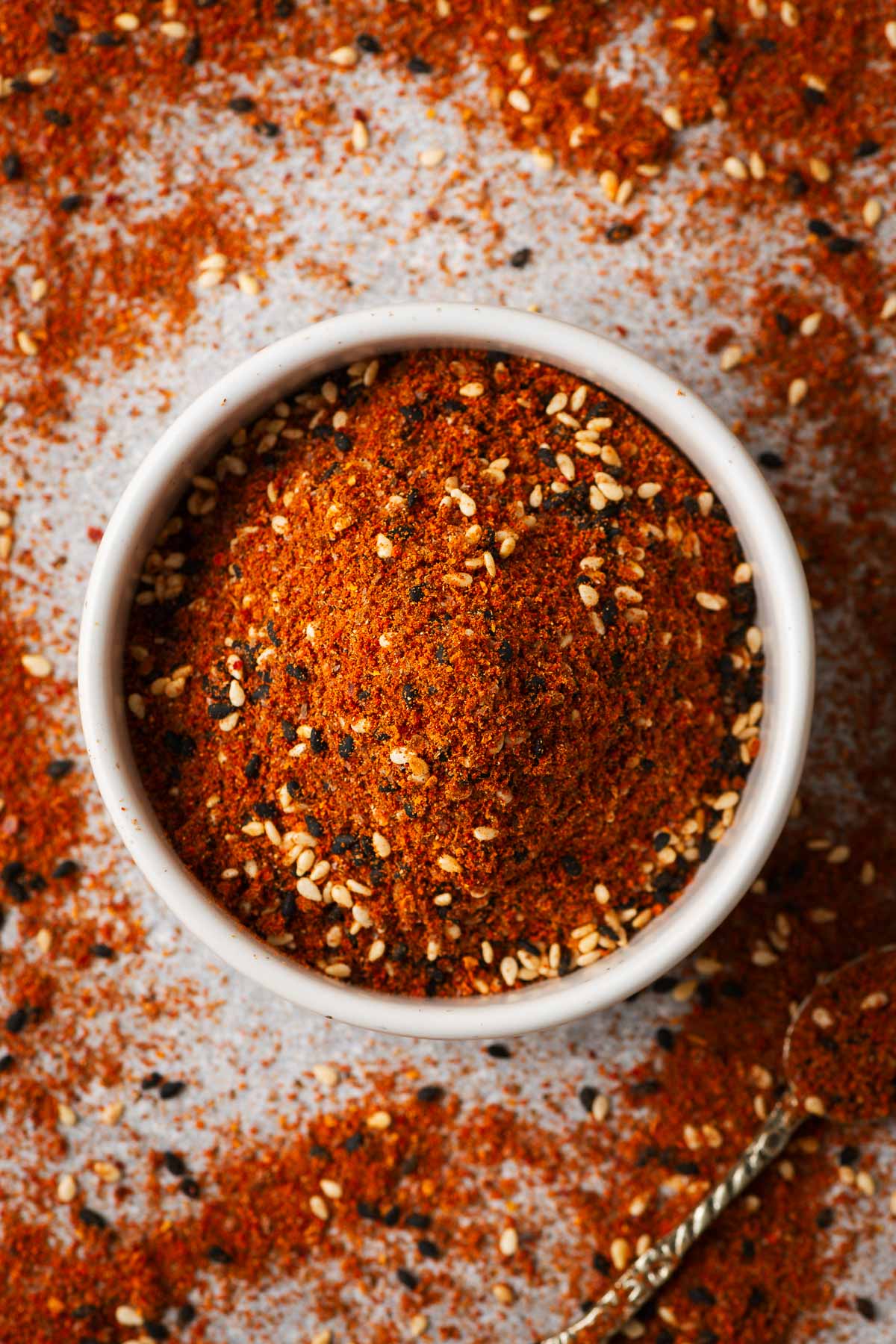Shichimi Togarashi (Japanese Seven Spice Blend)
Add a spicy umami kick to your favourite dishes with this homemade shichimi togarashi blend. It delivers instant flavour with spicy, citrusy and nutty notes and a hint of floral – perfect for noodles, rice and sushi!
Spice up your repertoire with the ultimate Japanese spice blend – shichimi togarashi. This versatile and delicious spice mix adds a fiery kick and depth of flavour to everything from noodle dishes and rice bowls to sushi and vegetables.
Shichimi togarashi, also known as nanami togarashi, translates to “seven-taste chile” in Japanese. And, while the recipe varies between cooks, it typically contains at least seven ingredients for a complex flavour profile, hence the nickname of Japanese seven spice.
But the best part? You can easily make the most delicious seven-spice blend at home with ingredients you likely already have available!

Why you’ll love this homemade spice blend
- Unique umami flavour: With toasted sesame seeds, nori seaweed, and orange or yuzu peel, this Japanese spice blend is utterly delicious and flavourful.
- Versatile: Use it to add flavour and heat to any dish from ramen and yakitori to grilled fish and vegetables. It’s also a great seasoning for rice, noodles, and sushi rolls.
- Customisable: Adjust the spice level to your liking by using your preferred type of chilli pepper and adding or subtracting chile powder.
- Easy to make: With just a few simple ingredients, you can have a jar of authentic Japanese shichimi togarashi ready to use in no time.
What is shichimi togarashi?
Shichimi togarashi means “seven-taste chile”. It is a popular spice blend used in Japanese cooking.
According to Nancy Singleton Hachisu in her cookbook “Japan“, it traditionally contains dried red chile japones, sansho pepper, dried tangerine or yuzu peel, dried ginger, green nori, hemp seeds, and white and black sesame seeds.
However, many variations of the spice blend exist. And, in this homemade shichimi togarashi recipe, I opted for the convenience of everyday ingredients swapping the sasho pepper for Sichuan and the yuzu peel for orange without compromising on any flavour.
Ingredients and substitutes







- Chile powder or flakes: I use gochugaru (Korean red pepper flakes) which I grind into a fine dried chilli powder. But you can use any chile powder or seedless red pepper flakes you prefer. However, if the dried chilli flakes are coarse, you’ll need to grind them into a fine powder first.
- Seaweed flakes: Dried seaweed is a key ingredient in shichimi togarashi, adding a distinct umami flavour. If you don’t have seaweed flakes, you can use a sheet of nori, shredded and blitzed into flakes.
- Sichuan peppercorns: An authentic shichimi togarashi blend needs the mouth-numbing citrusy flavour of Sichuan (Szechuan peppercorns) or Sansho peppercorns. You can use ground peppercorns, or grind whole ones into powder.
- Dried orange peel: This adds a bright citrus flavour to the blend. You can use either dried orange zest or powder, or any other dried citrus peel (like yuzu or tangerine peel). And, if you don’t have any, you can make your own by drying orange zest in the sun or in the oven. Learn how to make any dried citrus zest.
- Sesame seeds: White and black sesame seeds are traditionally used in shichimi togarashi. Buy toasted seeds, or toast them in a hot, dry pan for a few minutes. See how to toast sesame seeds for step-by-step ingredients.
- Ground ginger: The ginger powder adds a warm, spicy flavour to the blend.
- White pepper: Use ground white pepper or grind whole white peppercorns into a fine powder. I love the floral aroma that white pepper adds to shichimi togarashi, but you can skip it if you don’t have any.
- Poppy seeds (optional): These are often included in shichimi togarashi for added crunch and texture. If you don’t have poppy seeds, you can omit them and use more sesame seeds instead.

How to use shichimi togarashi
You can sprinkle shichimi togarashi over any finished dish that needs a flavour boost.
Noodles: Sprinkle it over a bowl of miso ramen or udon noodle soup for a spicy kick and added depth of flavour. Or add it to your soba noodle dipping sauce!
Miso Soup: Add a pinch of shichimi togarashi to your miso soup for a unique twist on a classic dish. The spice blend’s umami notes complement the savoury flavour of the miso.
Meat and Seafood: Use it as a dry rub for roasted or grilled meats and seafood. The blend’s spicy and nutty flavour pair well with beef, chicken, salmon, and shrimp. Or create a marinade by mixing shichimi with soy sauce.
Vegetables: Toss roasted vegetables with a sprinkle of shichimi togarashi for a delicious and unexpected twist. It works particularly well with root vegetables like sweet potatoes, carrots, and parsnips.
Snack Seasoning: Mix shichimi togarashi with some olive oil and sea salt flakes, then toss it with your favourite nuts or brush it over nori sheets. Then bake for a crunchy, flavour-packed snack. You can even sprinkle it over popcorn.
Eggs: If you, like me, enjoy a bit of spice in your morning routine. Sprinkle miso scrambled eggs with a little bit of shichimi.

Frequently asked questions
Shichimi togarashi is a popular Japanese spice blend used to add heat and flavour to a variety of dishes. It can be used as a seasoning for soups, noodles, rice dishes, meats, and vegetables. It can also be used as a condiment to sprinkle on top of dishes for an extra kick of flavour.
If you don’t have shichimi togarashi on hand, you can use a combination of red pepper flakes, black pepper, sesame seeds, and citrus zest as a substitute. Or try this shichimi togarashi recipe using only the ingredients you have on hand.
Yes, Japanese seven spice and shichimi togarashi are the same thing. They both refer to a blend of seven spices or more commonly used in Japanese cuisine. Shichimi togarashi translates to “seven-taste chile”.
No, shichimi togarashi and Chinese five-spice are not the same. Five-spice is a Chinese spice blend of star anise, cloves, cinnamon, Szechuan peppercorns, and fennel seeds. Shichimi togarashi, on the other hand, contains more ingredients, including chilli flakes, sesame seeds, and orange peel.
Recipes using shichimi togarashi
Use your homemade shichimi togarashi in these Japanese recipes, or simply sprinkle it on everything!

Equipment
- Spice grinder – or a coffee grinder, food processor, or pestle and mortar.
Ingredients
- 4 tablespoons chile powder or flakes* , I use gochugaru
- 2 tablespoons seaweed flakes* , or 1 nori sheet
- 1 tablespoon Sichuan peppercorns , ground or whole
- 1 tablespoon dried orange peel* , powder or zest
- 2 teaspoon white sesame seeds , toasted
- 2 teaspoon black sesame seeds , toasted
- 2 teaspoons ground ginger
- 2 teaspoons ground white pepper
- 2 teaspoons poppy seeds , or more sesame seeds
Instructions
- If you're using whole or coarse spices like red chilli flakes, a toasted nori sheet, whole Sichuan peppercorns, or orange peel (instead of powder): First, grind them into a fine powder using a food processor, spice grinder, coffee grinder, or mortar and pestle.
- Then, in a small bowl, mix all of the ingredients until well combined. Or shake, shake, shake them in a spice jar.
- Transfer the shichimi togarashi spice blend to an airtight container or clean spice jar and store it in a cool, dry place for up to 6 months, or until the colour starts to fade.
Notes
- I use gochugaru (Korean red pepper flakes) in my shichimi, but you can use your favourite chile powder. Just be mindful of the spiciness. If you want a milder spice blend: start by adding half the chile powder, then add more once you’ve tasted the final blend.
- I use a combination of black and white sesame seeds, but you can use either. And, if you don’t have store-bought toasted sesame seeds, simply toast raw sesame seeds in a hot, dry pan for a few minutes. Or see how to toast sesame seeds for more instructions.
- Use dried orange zest or powder. If you have dried orange peel strips, grind them into a powder first. It’s also super easy to make at home. See how to make dried citrus zest for step-by-step instructions.





I hope you love this shichimi togarashi recipe as much as I do! Leave a comment to let me know.